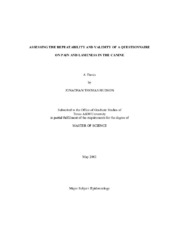| dc.contributor.advisor | Slater, Margaret | |
| dc.creator | Hudson, Jonathan Thomas | |
| dc.date.accessioned | 2004-09-30T01:40:31Z | |
| dc.date.available | 2004-09-30T01:40:31Z | |
| dc.date.created | 2003-05 | |
| dc.date.issued | 2004-09-30 | |
| dc.identifier.uri | https://hdl.handle.net/1969.1/28 | |
| dc.description.abstract | The measurement of pain has had a growing importance in animals for both privately owned animals and those animals involved in clinical research. Lameness is considered to be 1 aspect of the pain experience. The ability of a veterinarian to assess lameness during a routine orthopedic examination can be difficult given the short amount of time in which the clinician can observe the animal, and the fact that the animal is in a stressful environment. Thus, the input of the owner concerning the animal's well-being over an extended time period may be extremely useful to the clinician in assessing the degree of lameness of the animal. It was the purpose of this study to establish an instrument that was both repeatable and valid in assessing the degree of lameness. The instrument used was a questionnaire containing 39 questions in a visual analog scale format. A force platform was used as the gold-standard for detecting mechanical lameness. Peak vertical, cranial-caudal, and their associated impulses were forces used to determine lameness, along with maximum slope in some cases. A test-retest measure of repeatability was conducted on a subset of 19 dogs that were confirmed to have less than a 10% change in vertical peak force. Nineteen of the 39 questions were found to be repeatable based on a Spearman rank correlation. These 19 questions were then used as predictor variables in several multiple regression models which predicted force plate measurements. The result was 3 different models each containing 7 independent variables that were thought to be valid representations of the forces measured (vertical peak, vertical impulse, and propulsion peak forces). Each reduced model was found to fit the data as well as the full model containing all 19 of the repeatable questions. The composite of 11 questions from the 3 different models was used to calculate a total score. This total score was found to be significantly correlated with force plate measurements. These 11 questions should be useful to a clinician in detecting the degree of lameness in the dog. | en |
| dc.format.extent | 411174 bytes | en |
| dc.format.extent | 160389 bytes | en |
| dc.format.medium | electronic | en |
| dc.format.mimetype | application/pdf | |
| dc.format.mimetype | text/plain | |
| dc.language.iso | en_US | |
| dc.publisher | Texas A&M University | |
| dc.subject | repeatability | en |
| dc.subject | validity | en |
| dc.subject | lameness | en |
| dc.subject | questionnaire | en |
| dc.subject | canine | en |
| dc.title | Assessing the repeatability and validity of a questionnaire on pain and lameness in the canine | en |
| dc.type | Book | en |
| dc.type | Thesis | en |
| thesis.degree.department | Veterinary Anatomy and Public Health | en |
| thesis.degree.discipline | Epidemiology | en |
| thesis.degree.grantor | Texas A&M University | en |
| thesis.degree.name | Master of Science | en |
| thesis.degree.level | Masters | en |
| dc.contributor.committeeMember | Scott, H. Morgan | |
| dc.contributor.committeeMember | Kerwin, Sharon | |
| dc.contributor.committeeMember | Taylor, Lathrop | |
| dc.type.genre | Electronic Thesis | en |
| dc.type.material | text | en |
| dc.format.digitalOrigin | born digital | en |


